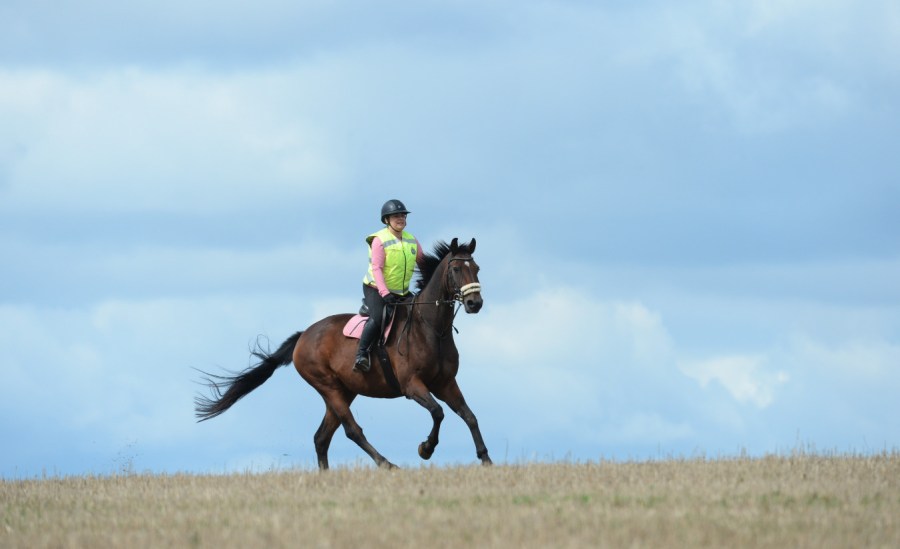#Hack1000Miles in partnership with Wintec…
You don’t need to save all your schooling for the arena – hacking is a fantastic time to work on your horse’s paces to improve their way of going.
“Hacking can improve a horse’s paces a lot,” says BHS Stage 4 coach Lisa Gilby. “Horses are much more willing to go forwards when they’re out hacking, so you can teach them to move off the leg more easily than in the school. The horse has got more respect, because you’ve been able to use light aids out hacking, which you can then bring into the arena.”
As well as improving forwardness, hacking is also an opportunity to address balance.
“If your horse is nice and forwards, but perhaps getting too fast or running away with you, you can use your half-halt to bring them back to you. This helps develop balance, because when done correctly it enables them to push from their hindquarters, lift their shoulder and take a bigger more balanced stride,” explains Lisa.
Hacking can improve your horse’s way of going in every gait, but it’s important that you work correctly whilst hacking.
“Improving your horse’s paces will make them more comfortable to ride, and better paces mean your horse is stronger and more balanced, so they are more capable of carrying you,” says Lisa. “Thinking of longevity, if your horse is working correctly then they will be putting less stress through their joints and body.”
Lisa explains how you can work your horse through each gait to improve their paces.
Improving the walk
“If you look at the scales of training, the base is rhythm. Hacking is a great time to work on your walk rhythm,” says Lisa. “Once your horse is happy to go forwards, you can start thinking about your rhythm.”
Once you’ve established a rhythm, you can start to progress further up the scales of training.
“Next is suppleness, and then contact. So you can start to do some lengthening and shortening – ask for a walk on a longer rein, then come back on a more collected walk,” suggests Lisa. “You could also add in some lateral movements, such as leg yield or shoulder-in. Now they’re moving off your leg, and your horse is learning to do that without realising they are learning because they are out hacking rather than doing circles in the school.”
Addressing the trot
Introducing lengthening of the stride in the arena can be tricky for horses to master, especially if they are young or green.
“When it comes to lengthening the trot stride, quite often in the school a horse will lose rhythm, rush and then fall onto their forehand. Then you have to half-halt, steady them, re-establish the working trot and ask again,” says Lisa.
If you’re struggling with this, then Lisa suggests heading out and finding a gentle incline to work on.
“To ask for that more powerful trot going uphill, they really have to push from behind,” explains Lisa. “Because they’re going uphill, they tend not to fall on the forehand. This means they’ll learn to carry themselves as they lengthen their stride, so develop a more powerful trot.”
Once you’ve established this going uphill, you can introduce it on the flat – in or out of the school.
“If you just hack, this is a nice exercise to keep your horse listening to you so you stay in control. If you compete, it’s a nice way to introduce exercises that benefit your horse’s schooling,” says Lisa.
Tackling the canter
“You can build the canter to be more powerful using the same exercise as in the trot, but you can also add things in like counter canter, even if you don’t do dressage,” explains Lisa.
Counter canter is good for getting your horse to engage their hindquarters and lift their shoulders, which helps to develop their balance.
“In the school, many horses find counter canter quite difficult. So if you’re hacking on a bridleway that bends to the right, ask your horse to strike off on the left lead. This way, you’re introducing the counter canter without having to make the tight turns you need to do in the school.”
Getting the gallop
Unless you have access to a gallop track, the only place you can teach your horse to gallop is out hacking because it’s the only place you have room.
“I see a lot of riders who event or jump practise a lot of showjumping, which means when they go cross-country they end up showjumping their cross-country round, because their horse hasn’t learned to go forwards and take a longer stride in balance,” explains Lisa. “They push their horse to go faster, but because the horse doesn’t know how to lengthen their stride, they take the same length stride, drop onto the forehand and move their legs faster.”
Being able to teach your horse to gallop properly, without falling onto the forehand, is key not only for success on the cross-country course, but also for keeping them safe and healthy in the long term.
“Similarly to the trot and canter, the gallop is the same: you’re asking your horse to push from behind to lengthen the stride. Just because it’s the top gear and you’re going faster doesn’t mean the training process has to be any different,” explains Lisa. “I would find a nice area with an incline and start to ask for more power. As soon as you feel your horse drop, or you’ve gone a little too far and it’s become too fast and on the forehand, then bring them back, re-settle and start again.”
Meet the expert: Lisa Gilby is a BHS Stage 4 Senior Coach and Centre 10 Advanced Coach. She is the manager of Warminster Saddle Club in Wiltshire, teaching military and civilian riders.
This content is brought to you in partnership with Wintec Saddles, durable, comfortable, easy-care, weather-proof saddles for everyone.








